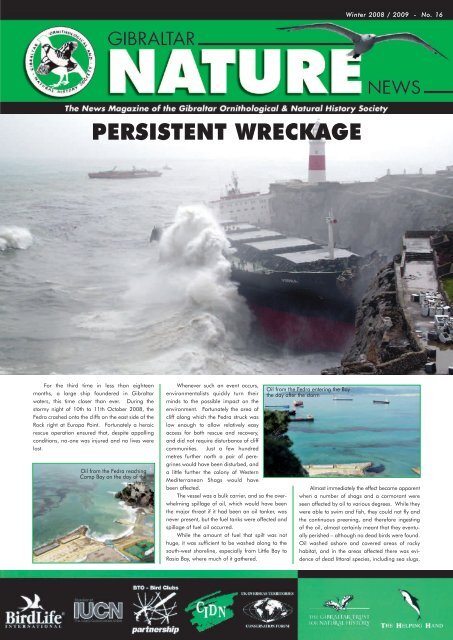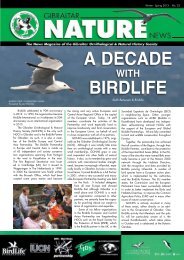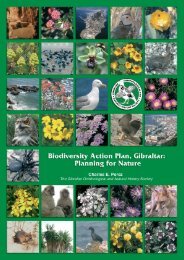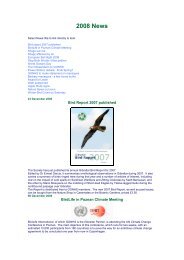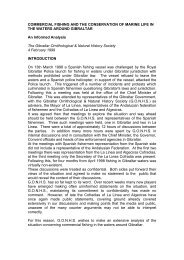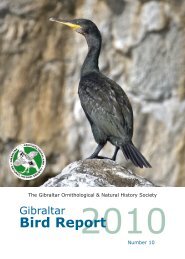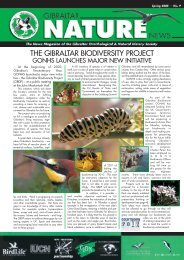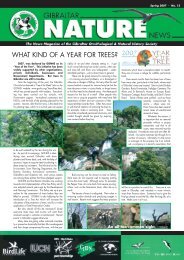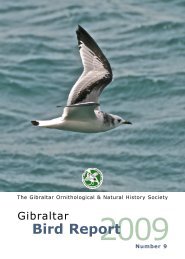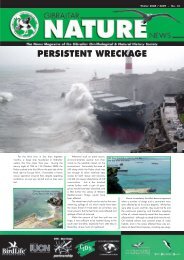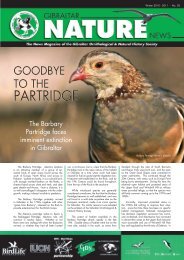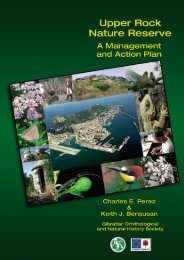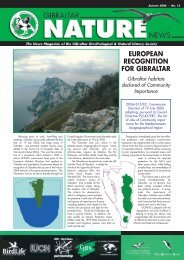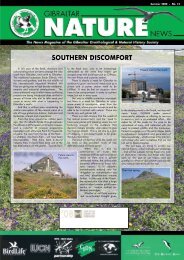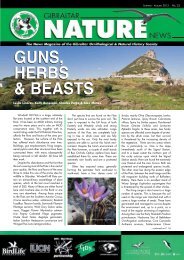No.16 - Gibraltar Ornithological & Natural History Society
No.16 - Gibraltar Ornithological & Natural History Society
No.16 - Gibraltar Ornithological & Natural History Society
Create successful ePaper yourself
Turn your PDF publications into a flip-book with our unique Google optimized e-Paper software.
PERSISTENT WRECKAGE<br />
For the third time in less than eighteen<br />
months, a large ship foundered in <strong>Gibraltar</strong><br />
waters, this time closer than ever. During the<br />
stormy night of 10th to 11th October 2008, the<br />
Fedra crashed onto the cliffs on the east side of the<br />
Rock right at Europa Point. Fortunately a heroic<br />
rescue operation ensured that, despite appalling<br />
conditions, no-one was injured and no lives were<br />
lost.<br />
Oil from the Fedra reaching<br />
Camp Bay on the day of the<br />
storm<br />
Whenever such an event occurs,<br />
environmentalists quickly turn their<br />
minds to the possible impact on the<br />
environment. Fortunately the area of<br />
cliff along which the Fedra struck was<br />
low enough to allow relatively easy<br />
access for both rescue and recovery,<br />
and did not require disturbance of cliff<br />
communities. Just a few hundred<br />
metres further north a pair of peregrines<br />
would have been disturbed, and<br />
a little further the colony of Western<br />
Mediterranean Shags would have<br />
been affected.<br />
The vessel was a bulk carrier, and so the overwhelming<br />
spillage of oil, which would have been<br />
the major threat if it had been an oil tanker, was<br />
never present, but the fuel tanks were affected and<br />
spillage of fuel oil occurred.<br />
While the amount of fuel that spilt was not<br />
huge, it was sufficient to be washed along to the<br />
south-west shoreline, especially from Little Bay to<br />
Rosia Bay, where much of it gathered.<br />
Oil from the Fedra entering the Bay<br />
the day after the storm<br />
Winter 2008 / 2009 - No. 16<br />
Almost immediately the effect became apparent<br />
when a number of shags and a cormorant were<br />
seen affected by oil to various degrees. While they<br />
were able to swim and fish, they could not fly and<br />
the continuous preening, and therefore ingesting<br />
of the oil, almost certainly meant that they eventually<br />
perished – although no dead birds were found.<br />
Oil washed ashore and covered areas of rocky<br />
habitat, and in the areas affected there was evidence<br />
of dead littoral species, including sea slugs,
GIBRALTAR NATURE NEWS<br />
2<br />
PERSISTENT WRECKAGE – THE<br />
FEDRA 1 & 16<br />
EDITORIAL 2<br />
STAMPS ON BIRDS 2<br />
GIBMANATUR INTERREG PROJECT 3<br />
SMIR WETLANDS 4 & 5<br />
GIBRALTAR AND THE STRAIT 6 & 7<br />
EL BUJEO 8 & 9<br />
MONARCH BUTTERFLIES 10<br />
BIRDING SCENE 10<br />
EUROPEAN BAT NIGHT 10<br />
INTERNATIONAL CAVE MONITORING<br />
FIELD WORKSHOP 11<br />
CAPE TRAFALGAR 12 & 13<br />
TETOUAN – MOUNTAINS AND<br />
COASTLINE 14 & 15<br />
The articles on pages 4-5, 6-7,8-9,12-13,<br />
and 14-15 are generated by GIBMANA-<br />
TUR I and II, the EU-<strong>Gibraltar</strong><br />
Government co-funded Interreg IIIA<br />
Project partnership between the <strong>Gibraltar</strong><br />
<strong>Ornithological</strong> & <strong>Natural</strong> <strong>History</strong> <strong>Society</strong><br />
and the University Mohammed V<br />
Rabat-Agdal.<br />
Leslie Linares<br />
Charles Perez<br />
Keith Bensusan<br />
John Cortes<br />
Janet Howitt<br />
Jean Paul Latin<br />
PHOTO CREDITS<br />
Published by the<br />
<strong>Gibraltar</strong> <strong>Ornithological</strong> & <strong>Natural</strong> <strong>History</strong> <strong>Society</strong><br />
<strong>Natural</strong> <strong>History</strong> Field Centre, Jewsʼ Gat e,<br />
Upper Rock Nature Reserve<br />
P.O.Box 843, <strong>Gibraltar</strong><br />
Tel. 200 72639 - Fax. 200 74022<br />
e-mail: naturenews@gonhs.org<br />
http//:www.gonhs.org<br />
Editorial team:<br />
John Cortes,<br />
Leslie Linares,<br />
Charles Perez,<br />
Keith Bensusan.<br />
Dave Mattey<br />
Mohamed Mouna<br />
Eric Shaw<br />
Ian Thompson<br />
Harry Van Gils<br />
Designed and printed by<br />
Roca Graphics Ltd. <strong>Gibraltar</strong><br />
21 Tuckeys Lane, <strong>Gibraltar</strong>.<br />
Tel. +350 200 57955<br />
Editorial<br />
ANOTHER YEAR LOOMING<br />
As another year gets into gear, many feel<br />
that <strong>Gibraltar</strong> is largely buffered from the socalled<br />
economic crisis that the developed<br />
world has entered, although probably the<br />
drop in value of the pound sterling against<br />
the euro will itself hit <strong>Gibraltar</strong> hard enough.<br />
We need to take a moment to consider how<br />
the situation is likely to affect the natural environment.<br />
Like so much in life, it is a doubleedged<br />
sword. On the one hand it is possible<br />
that the galloping demand by firms to build<br />
over more and more of <strong>Gibraltar</strong> will<br />
decrease, especially when the developers are<br />
companies that may be feeling the crunch<br />
elsewhere. While no-one will welcome what<br />
this may mean to those employed in the construction<br />
industry, there is no doubt that<br />
<strong>Gibraltar</strong> can do with some breathing space<br />
At the beginning of the year the <strong>Gibraltar</strong><br />
Philatelic Bureau issued a definitive series of<br />
stamps depicting a selection of some of<br />
<strong>Gibraltar</strong>’s most charismatic birds. The birds<br />
were chosen by GONHS, who were consulted<br />
by the designer Stephen Perera. They include<br />
some of our most attractive and spectacular<br />
migrants and more interesting resident birds:<br />
among them raptors, passerines and<br />
seabirds.<br />
Stephen prepared the designs with the<br />
help of good photographs and a selection,<br />
supplied by GONHS, of views of the habitats,<br />
which the birds frequent during their stay on<br />
the Rock. The resulting designs were<br />
astounding, and these were sent to the illustrator<br />
in the United Kingdom, Jonathan<br />
Pointer, who with a marvellous artistic flair,<br />
managed to capture the atmospheric qualities<br />
and lighting, to produce a truly magnificent<br />
set of stamps.<br />
The thirteen designs, cover values from<br />
1p to £5, among which the Bee-eater is used<br />
locally, the Blue-Rock Thrush for postage to<br />
the United Kingdom and the Hoopoe for let-<br />
GIBRALTAR STAMPS<br />
to take stock of where urban development<br />
can go to next. On the other hand, the economic<br />
downturn may make people think twice<br />
before investing in new clean or environmentally<br />
friendly technologies, while at the same<br />
time there will be a positive incentive to<br />
reduce consumption of water and electricity in<br />
order simply to save money.<br />
However it affects the environment, one<br />
thing is sadly true. As the consumers in the<br />
consumers’ world tighten their belts they’ll be<br />
thinking less about the green around them<br />
and more about the green in their pockets.<br />
The difficult times for the capitalist economies<br />
may not necessarily be better times for<br />
Nature.<br />
John Cortes<br />
ters to the European Union.<br />
The set is available online from the<br />
<strong>Gibraltar</strong> Philatelic Bureau at<br />
http://www.gibraltar-stamps.com.
GIBMANATUR:<br />
<strong>Gibraltar</strong>-Morocco Interreg Project news<br />
The <strong>Gibraltar</strong>-Morocco Interreg IIIA<br />
Project GIBMANATUR (I and II), a collaboration<br />
between GONHS and the Institut<br />
Scientifique of the Université Mohammed V<br />
Rabat-Agdal, has sadly come to an end. The<br />
project, which started in 2003 with a major<br />
conference on the Barbary macaque, has<br />
been a great success. One of its main aims<br />
was to establish close links between <strong>Gibraltar</strong><br />
and Morocco and it has done so overwhelmingly<br />
well.<br />
Among the main activities of the project<br />
was a bird ringing programme during the<br />
spring and autumn months of 2004 to 2008.<br />
The operations were extremely successful and<br />
5344 birds were processed in total. The<br />
species present and their patterns of occurrence<br />
have revealed interesting facts about<br />
the marshes of Restinga-Smir, as a site. Smir<br />
is an important wintering site for Penduline<br />
Tits: it has emerged that they are regular here<br />
and nowhere else in Morocco, and the population<br />
is larger than anyone had thought.<br />
Extensive surveys of birds in different habitats<br />
in the area have also been carried out, as well<br />
as surveys in other areas, especially wetlands,<br />
of northern Morocco.<br />
Another important part of Interreg was<br />
the extensive winter surveys of wetland birds<br />
in northern Morocco, a contribution to the<br />
national wetland bird count co-ordinated<br />
every year by the Institut. Areas covered by<br />
the GONHS team include Smir on the<br />
Mediterranean coast to Asilah and Larache<br />
on the Atlantic side.<br />
Interesting results have been obtained<br />
both from the ringing data and the bird surveys.<br />
Some of the species recorded are rare<br />
in Morocco and any records of these contribute<br />
to knowledge of their status and distribution.<br />
These include: Great Bittern, Little<br />
Bittern, Great Egret, Marbled Duck,<br />
Ferruginous Duck, Great Bustard, Spotted<br />
and Little Crake, Jack Snipe, Lesser Crested<br />
Tern, Moustached Warbler, Penduline Tit,<br />
Alpine Chough and Tree Sparrow. Other<br />
species recorded are true vagrants: Ringnecked<br />
Duck, Rüppell’s Vulture, Icterine<br />
Warbler, Lesser Whitethroat and Hooded<br />
Crow.<br />
As part of the bird ringing programme,<br />
GONHS volunteer and ringing trainer Ian<br />
Thompson has trained two Moroccan students<br />
from the University of Tetouan:<br />
Mohamed Amezian and Abdelahak Elbanak.<br />
Mohamed was further assisted with a scholarship<br />
from GONHS, which he fully deserved<br />
given his impressive academic ability and<br />
eagerness to learn. He has now obtained his<br />
BTO C-grade ringing license and a Moroccan<br />
ringing license. We hope that the students,<br />
and Mohamed in particular, will continue to<br />
ring in Morocco for years to come.<br />
As a result of Interreg, a series of publications<br />
have already been produced by the<br />
<strong>Gibraltar</strong> and Moroccan partners, dealing<br />
mainly with birds and invertebrates in northern<br />
Morocco. More publications will follow<br />
soon, including some on plants.<br />
A report on the project is currently being<br />
prepared, to be submitted to the EU and the<br />
<strong>Gibraltar</strong> Government, who co-sponsored the<br />
project.<br />
The project came to a close with a two<br />
week expedition to the south of Morocco in<br />
November, in order to survey habitats, and<br />
record and collect succulent plants, invertebrates,<br />
birds, reptiles, amphibians and scorpions.<br />
The range of habitats sampled was<br />
enormous, from the Alpine High Atlas to the<br />
desert near Algeria and the arid Atlantic coast<br />
of southwest Morocco. The work will further<br />
help discover and understand Morocco’s biodiversity.<br />
Even though the project is now over, we<br />
will continue to work closely with our<br />
Moroccan colleagues at the Universities of<br />
Rabat and Tetouan, which we view as permanent<br />
partners. Given<br />
the strong links<br />
forged between us,<br />
there is a strong<br />
desire to work<br />
together in the future.<br />
Although funding for<br />
<strong>Gibraltar</strong>-Morocco<br />
has not been<br />
approved for the next<br />
tranche of EU funding,<br />
GONHS will<br />
continue to explore<br />
avenues to ensure<br />
that our collaboration<br />
continues.<br />
Expedition to southern Morocco (2008)<br />
Abdelahak Elbanak &<br />
Mohamed Amezian training<br />
at Jews’ Gate, <strong>Gibraltar</strong><br />
NOTES & NEWS<br />
BRANCHED CARLINE THISTLE<br />
The flat-topped carline thistle Carlina hispanica<br />
is very common and widespread on the Rock.<br />
On the other hand, the Branched carline thistle<br />
Carlina racemosa is very rarely seen. This year,<br />
after twenty years since the last one was seen on<br />
the Rock at Bruce’s Farm firebreak, a solitary<br />
plant appeared in the Alameda Botanic<br />
Gardens. The plant was quite small, and failed<br />
to provide viable seeds.<br />
CHRISTIANNE’S DIARY<br />
“My Nature Diary” by Christianne Fagan published<br />
as a limited edition just before Christmas<br />
is a delightful look at nature in <strong>Gibraltar</strong><br />
through a schoolgirl’s eyes. Written in the early<br />
1980s, it records, in text, sketches and water<br />
colours, many different aspects of nature, many<br />
in the Botanic Gardens which the author frequented<br />
as a child. The notes are fascinating –<br />
and while not meant to be a textbook, give a<br />
real feel for what nature in <strong>Gibraltar</strong> has to<br />
offer. Many of the descriptions are exquisite,<br />
and to anyone who has lived in the same space<br />
as Christianne, generate an intense feeling of<br />
nostalgic warmth. A charming book that every<br />
nature lover with a connection with <strong>Gibraltar</strong><br />
should have – and will treasure.<br />
CLEARING OF CHASMANTHE<br />
ON ST MICHAEL’S CAVE FIRE-<br />
BREAK<br />
For the past couple of years, the Upper Rock<br />
Team currently working under GONHS have<br />
been removing introduced species of plants<br />
from various places around the Nature Reserve.<br />
Recently they have turned their attention to<br />
removing the African Corn Flag Chasmanthe<br />
floribunda. This South African species is a garden<br />
escape, and has established itself in several<br />
places within the Nature Reserve, especially<br />
on the firebreak near St Michael’s Cave. It is an<br />
aggressive species, out-competing native<br />
species at an alarming rate on clearings and<br />
along roadsides. The Team has a hard task<br />
ahead of them!<br />
GIBRALTAR NATURE NEWS<br />
3
GIBRALTAR NATURE NEWS<br />
4<br />
ONCE AGAIN, WE ARE DEDICATING PART OF NATURE NEWS TO PROMOTING KNOWLEDGE OF<br />
SOME OF THE MAIN WILDLIFE SITES OF THE STRAIT OF GIBRALTAR<br />
Information used in these articles was collected during GIBMANATUR, the <strong>Gibraltar</strong>-Morocco Interreg IIIA<br />
project of collaboration between GONHS and the Institut Scientifique of the University of Rabat-Agdal<br />
Reeds and rushes in smir marsh<br />
The wetlands of Smir lie north of the city of<br />
Tetouan, separated from the lowlands below the<br />
city by the headland and hills of Cabo Negro. To<br />
the north of Smir are the foothills of Jbel Moussa,<br />
to the west a continuation of the limestone mountains<br />
that encircle Tetouan, and to the east the<br />
Mediterranean Sea.<br />
Visitors to the area will often drive along the<br />
coast road south from the Spanish enclave of<br />
Ceuta (Sebta) towards the town of M’diq, and, if<br />
they turn their eyes away from the yacht marina<br />
inland, will think that the wetland consists simply of<br />
one lagoon. In fact, although much decreased in<br />
size through recent decades, the wetlands and a<br />
complex of marsh, lagoons and a reservoir make<br />
up the most important wetland habitat on the east<br />
side of the Tangier Peninsula.<br />
The zone covers a surface area of about 175<br />
hectares. While it has a typical Mediterranean climate,<br />
its proximity to the Strait of <strong>Gibraltar</strong> makes<br />
SITES AROUND THE STRAIT 5<br />
THE SMIR WETLANDS<br />
it subject to high winds.<br />
Rainfall is over 600 mm<br />
per annum.<br />
Apart from direct<br />
rainfall, there are several<br />
main sources of water<br />
feeding the wetland. The<br />
sea enters the easternmost<br />
lagoon which is<br />
brackish and has surrounding<br />
it a vegetation<br />
typical of salt marsh. A<br />
significant amount of<br />
water enters the marsh<br />
from the south from the<br />
sewage outflow of M’diq.<br />
A considerable amount of<br />
groundwater flows in from<br />
the surrounding limestone<br />
hills, while the river Smir<br />
and several other smaller<br />
streams also supply water to the system.<br />
There are a number of important habitats in<br />
the area, all more or less influenced by the wetland<br />
system. One of these is made up of several areas<br />
of Tamarisk Tamarix africana scrub, much used by<br />
resident and migrant passerine birds especially<br />
when they are in flower as they have many invertebrates.<br />
Another sizeable area is made up of<br />
rushes Juncus spp., and also of bulrushes Typha<br />
spp. and reeds Phragmites australis. Around the<br />
eastern lagoon is a typical low salt marsh vegetation<br />
dominated by glassworts.<br />
One of the main habitats for birds over recent<br />
years has been the “new lagoon” created when the<br />
new Tetouan-Tangier motorway blocked drainage<br />
in a series of fields and result in flooding. The<br />
main vegetation here is the reed Phragmites australis.<br />
Deeper waters are provided by the nearby<br />
Smir reservoir or barrage.<br />
The whole of the area is extremely interesting<br />
for its fauna. Despite regular spraying to control<br />
mosquitoes, there are interesting invertebrates<br />
including several dragonflies rare in Morocco.<br />
Reptiles and amphibians, in particular Moroccan<br />
Toads Bufo mauritanicus and Stripeless Tree Frogs<br />
Hyla meridionalis abound and are most obvious<br />
and vociferous in spring.<br />
But it is for birds that the Smir wetlands stand<br />
out. It is a vital link in the chain for migrant birds,<br />
not just from wetland habitats, as data collected<br />
during GIBMANATUR has shown. It is also an<br />
important wintering site for many species, including<br />
Shoveler Anas clypeata, Common Coot Fulica<br />
atra and Penduline Tits Remiz pendulinus, considered<br />
a rarity in Morocco before our study. Tufted<br />
Duck Aythya fuligula are regular in Barrage Smir.<br />
Barrage Smir<br />
Possibly of greatest interest is the community<br />
of resident birds, some of which are of species rare<br />
or absent in the rest of Morocco – and indeed from<br />
the area of the Strait. Smir is considered among<br />
the seven top sites for wintering waterbirds in<br />
Morocco.<br />
The most significant discoveries of GIB-<br />
MANATUR are probably those related to nesting
Bufo mauritanicus<br />
Phragmites australis<br />
New Lagoon<br />
Purple swamphen<br />
Hyla meridionalis<br />
birds. There are 26 species of birds usually associated<br />
with wetlands nesting at Smir. These include<br />
5 herons, 5 from the rail family and 5 warblers.<br />
Six species have been recorded nesting at Smir for<br />
the first time, these being the Red-crested Pochard<br />
Netta rufina, the Red-knobbed Coot Fulica cristata,<br />
the Great Crested Grebe Podiceps cristatus, the<br />
Little Ringed Plover Charadrius dubius, the River<br />
Kingfisher Alcedo atthis and Savi’s Warbler<br />
Locustella luscinioides.<br />
There is a sizeable heronry with numbers of<br />
Cattle Egrets Bubulcus ibis and Little Egrets Egretta<br />
garzetta, Squacco Herons Ardeola ralloides and<br />
Black-crowned Night Herons Nycticorax nycticorax,<br />
and Eurasian Spoonbills Platalea leucorodia,<br />
which first nested there in 1994. Glossy Ibises<br />
Plegadis falcinellus are frequent and regular and<br />
would be expected to nest there soon, provided the<br />
habitat survives. At least ten pairs of Purple Heron<br />
Ardea purpurea also nest there – a species very<br />
much in decline in Morocco. Other nesting species<br />
include Reed Warbler Acrocephalus scirpaceus and<br />
Great Reed Warbler Acrocephalus arundinaceus.<br />
Purple Swamphens Porphyrio porphyrio are common<br />
– over 120 counted in May 2006, probably<br />
representing the most important population in<br />
Morocco.<br />
Significantly, many species were confirmed<br />
nesting in the New Lagoon, and others may do so,<br />
including Ferruginous Duck Aythya nyroca, while<br />
others species, such as Whiskered Tern Chlidonias<br />
hybrida and Great White Egret Egretta alba turn<br />
up regularly. It is quite impressive to see a habitat<br />
become so important for birds in just a few<br />
years, and shows the resilience of the species in<br />
question and the logic of habitat creation and<br />
restoration in the region.<br />
However, as reported in <strong>Gibraltar</strong> Nature<br />
News 14, there is still concern about the future of<br />
the Smir marshes, particularly as the dumping of<br />
spoil continues and the threat from various developments<br />
increases. This is occurring in spite of the<br />
site being included in the planned intercontinental<br />
Biosphere Reserve linking Spain and Morocco. For<br />
now the future of the site remains uncertain, but we<br />
hope that if we combine our effort with that of our<br />
Moroccan colleagues, we could manage to influence<br />
the protection of at least some of the wetland<br />
habitat that exists here.<br />
Maximum counts of selected<br />
wetland bird species<br />
Species Max. counts<br />
Little Grebe 68<br />
Great Crested Grebe 45<br />
Cattle Egret 3159<br />
Squacco Heron 17<br />
Purple Heron 18<br />
Glossy Ibis 146<br />
Eurasian Spoonbill 26<br />
Greater Flamingo 350<br />
Greylag Goose 99<br />
Eurasian Wigeon 718<br />
Common Teal 364<br />
Mallard 371<br />
Northern Shoveler 1472<br />
Red-crested Pochard 259<br />
Common Pochard 335<br />
Tufted Duck 51<br />
Common Coot 2000<br />
Red-knobbed Coot 116<br />
Purple Swamphen 154<br />
Stone Curlew 40<br />
Ringed Plover 60<br />
Northern Lapwing 90<br />
Black-tailed Godwit 84<br />
Eurasian Curlew 23<br />
Smir wetland<br />
Dumping threatens Smir marsh<br />
GIBRALTAR NATURE NEWS<br />
5
GIBRALTAR NATURE NEWS<br />
6<br />
Although previous issues of Nature News have<br />
included various articles about the flora and fauna<br />
of <strong>Gibraltar</strong>’s coastline, the celebration of the Year<br />
of the Strait during 2008 would not be complete<br />
without including another one this year.<br />
<strong>Gibraltar</strong>’s natural coastline has been under<br />
heavy pressure from developers for some time now,<br />
and this pressure continues unabated. Less and less<br />
of it remains in its natural state, most of it being<br />
coastal cliffs around the southern parts of the Rock.<br />
On the whole these cliffs rise sheer from the sea,<br />
stretching from just south of Sandy Bay all the way<br />
round to Europa Point, and then on to Little Bay. A<br />
surprisingly large number of species of plants cling<br />
to them, surviving under quite harsh conditions. Less<br />
difficult conditions can be found where the coastline<br />
drops more gently towards the sea forming a rocky<br />
The mound at Europa point<br />
SITES AROUND THE STRAIT 6<br />
GIBRALTAR AND THE STRAIT<br />
shoreline. This can be seen at the Europa Point foreshore,<br />
from Little Bay to the South Mole, and to a<br />
limited extent between Catalan Bay and Sandy Bay.<br />
The <strong>Gibraltar</strong> sea lavender Limonium emarginatum<br />
is a common and widespread species all<br />
around the littoral. A large number can also be seen<br />
on the cliffs below Windmill Hill Flats, and a few on<br />
the North Face. Some can even be seen as far up as<br />
Martin’s Cave! This species is endemic to the Strait<br />
of <strong>Gibraltar</strong> and could well be considered the<br />
emblematic species of the Strait. Other than at<br />
<strong>Gibraltar</strong>, good stands can be seen along the Ceuta<br />
coast, at the Isla de las Palomas in Tarifa, and along<br />
the coast below Jbel Moussa. The plants found at the<br />
latter site are very stunted, with tiny leaves and very<br />
short flowering stems. This is probably due to the<br />
very high winds that blow continually along this part<br />
Lavatera mauritanica subsp davaei<br />
of the Strait.<br />
The vegetation that is found where the sea cliffs<br />
level off at the top is quite rich. This is very evident<br />
along Europa Advance Road, the mound at Europa<br />
Point and on the waste ground to the west and<br />
above the Mosque. The predominant species seen<br />
here are the winged sea lavender Limonium sinuatum,<br />
the wild carrot Daucus carota, the sea heath<br />
Frankenia laevis, the sea daisy Pallenis maritima, the<br />
purple viper’s bugloss Echium plantagineum, the<br />
rock samphire Crithmum maritimum, the bitter fennel<br />
Foeniculum vulgare subsp piperitum, the cineraria<br />
Senecio cineraria, the blunt-leaved catchfly Silene<br />
obtusifolia, the wild radish Raphanus raphanistrum,<br />
the squirting cucumber Ecballium elaterium and two<br />
species of mallow: the tree mallow Lavatera arborea<br />
and the Moroccan mallow Lavatera mauritanica<br />
subsp davaei. These species, together with many<br />
others, form a unique community of plants, typical<br />
of the littoral.<br />
The mount at Europa Point is also home to a<br />
number of rarer species such as the pink sandwort<br />
Minuartia geniculata, the Barbary nut Gynandriris<br />
sisyrinchium and the romulea Romulea clusiana;<br />
whilst down on the foreshore one can find important<br />
species such as the coastal ragwort Senecio leucanthemifolius<br />
which is becoming very rare in other<br />
parts of the Strait, and the shrubby seablite Suaeda<br />
vera which, on the Rock, is only found here.<br />
Lastly, it is worth mentioning the Tangier fennel<br />
Ferula tingitana and the <strong>Gibraltar</strong> candytuft Iberis<br />
gibraltarica. Both these plants are not coastal<br />
species, but they do link <strong>Gibraltar</strong> to Morocco. The<br />
candytuft is a North African species but is also found<br />
wild on the Rock and no-where else outside Africa.<br />
The fennel grows very well on the Rock as it does in<br />
the Tangier Peninsula, but is quite rare elsewhere in<br />
the Iberian Peninsula.<br />
Coastal flora along the top of the east side cliffs
Senecio leucanthemifolius<br />
Gynandridis sisyrinchium<br />
Limonium emarginatum<br />
Iberis gibraltarica<br />
Foeniculum vulgare subsp piperitum<br />
Ferula tingitana<br />
NOTES & NEWS<br />
DATABASING OF MOROCCO’S<br />
SUCCULENT PLANTS<br />
Following the Institut Scientifique de Rabat and<br />
GONHS-led visit to the south of Morocco, Dr<br />
Keith Bensusan of the <strong>Gibraltar</strong> Botanic<br />
Gardens has undertaken to coordinate a databasing<br />
system for Moroccan succulent plants<br />
that are found in the collections of botanic gardens<br />
and private collectors around the world.<br />
This is because many of these plants are restricted<br />
to Morocco, where the immense pressure<br />
placed on habitats by human activities threaten<br />
some of these species. The project aims to catalogue<br />
Moroccan plants in cultivation and promote<br />
the exchange of plant material, information<br />
and ideas between collections. The initiative<br />
has already attracted some interest and we<br />
hope that it will provide exciting results for the<br />
conservation of plants in Morocco.<br />
EXPEDITION TO THE SOUTH<br />
OF MOROCCO<br />
The final field trip under the GIBMANATUR<br />
project took place in November. The expedition<br />
took a team of botanists, entomologists<br />
(Arthropods), malacologists (Molluscs), herpetologists<br />
(Reptiles & Amphibians) and<br />
ornithologists to a large range of habitats in the<br />
south of Morocco, from the deserts close to the<br />
Algerian border and the arid southwest Atlantic<br />
coast, to the alpine High Atlas. The team<br />
included members of GONHS, the Institut<br />
Scientifique de Rabat, the University of Tetouan<br />
and the <strong>Gibraltar</strong> Botanic Gardens. A number<br />
of exciting finds were made and are being written<br />
up for publication in peer-reviewed journals.<br />
A report on this very fruitful trip will appear in<br />
the next issue of <strong>Gibraltar</strong> Nature News.<br />
EXPERT BUZZES ON<br />
GIBRALTAR’S DIPTERA<br />
Martin Ebejer is a dipterist based in the UK. He<br />
visited <strong>Gibraltar</strong> for a few days in late<br />
September and early October, following an<br />
invitation from his friend Rhian Guillem of the<br />
GONHS Invertebrate Section. Martin is an<br />
expert on Mediterranean Diptera (true flies). He<br />
spent his time on <strong>Gibraltar</strong> surveying the<br />
Diptera fauna of the main habitats on the Rock.<br />
He also offered very valuable advice to members<br />
of the Invertebrate Section on a wide range<br />
of issues, from sampling of invertebrates to<br />
curation of collections and beyond. During his<br />
visit, Martin collected close to 200 species of<br />
Diptera from <strong>Gibraltar</strong>, among which are some<br />
notable finds that will be reported on in due<br />
course. No stranger to the Mediterranean, this<br />
was nevertheless Martin’s first visit to the Rock.<br />
We hope that his results prove fruitful. The<br />
GONHS Invertebrate section gratefully appreciated<br />
Martin’s efforts, and hopes that his first visit<br />
will not be his last.<br />
JOHN CORTES ON FORUM<br />
COUNCIL<br />
GONHS General Secretary Dr John Cortes<br />
was elected to Council of the UK Overseas<br />
Territories Conservation Forum at its Annual<br />
General Meeting in December 2008. John has<br />
been active in the Forum for some years as the<br />
GONHS representative and will contribute to<br />
Council many years of experience in the field of<br />
nature conservation.<br />
GIBRALTAR NATURE NEWS<br />
7
GIBRALTAR NATURE NEWS<br />
8<br />
The sierras near the Spanish shore of the<br />
Strait are composed of sandstone. They have<br />
acidic soils and are shrouded partly or entirely in<br />
woodland that is composed primarily of Cork<br />
Oaks Quercus suber. These woodlands are<br />
known for their exceptionally rich flora and<br />
fauna and it is no surprise that they fall within a<br />
Nature Reserve. At some 177,000 ha., the<br />
‘Parque <strong>Natural</strong> de Los Alcornocales’ is not only<br />
the third-largest protected area in Andalucía, but<br />
also one of the most extensive in the whole of<br />
Spain. The Sierra del Bujeo, between Algeciras<br />
and Tarifa, is one of the highest mountains in<br />
this Nature Reserve. At more than 800m above<br />
sea level, it is double the height of the Rock of<br />
<strong>Gibraltar</strong>, which faces it across the Bay.<br />
The Sierra del Bujeo is itself dominated by<br />
Cork Oak woodland. The flora is characteristic<br />
of habitats with acidic soils. Alongside the Cork<br />
Oaks grow the smaller Strawberry Trees Arbutus<br />
unedo and deciduous Alder Buckthorn Frangula<br />
alnus. The former is the food plant of the large<br />
and attractive Two-tailed Pasha butterfly<br />
Charaxes jasius. Gorses and heaths predominate<br />
in the understorey, with other smaller plants<br />
such as Sage-leaved Cistus Cistus salvifolius and<br />
Genista tridentata occurring at lower densities.<br />
The Gorse Ulex borgiae is endemic to southernmost<br />
Spain and is abundant at El Bujeo. The<br />
most common heath species at this site is the<br />
green-flowered Erica scoparia. However, the<br />
Tree Heath Erica arborea and Southern Heath<br />
Erica australis are fairly common, as is Heather<br />
Calluna vulgaris. A special plant that grows well<br />
on banks is the carnivorous Drosophyllum lusitanicum.<br />
This species is almost endemic to habitats<br />
with acid soils on both sides of the Strait, with<br />
some populations in Portugal.<br />
The Cork Oak woodlands in southern Spain<br />
are very rich in birdlife. Even by their standards<br />
Bonelli’s Warbler<br />
SITES AROUND THE STRAIT 7<br />
EL BUJEO<br />
however, El Bujeo has an exceptionally rich avifauna.<br />
Typical species of these woods include<br />
the European Robin Erithacus rubecula, Crested<br />
Tit Lophophanes cristatus, Blue Tit Cyanistes<br />
caeruleus, Great Tit Parus major, Firecrest<br />
Regulus ignicapillus, European Nuthatch Sitta<br />
europaea, Short-toed Treecreeper Certhia<br />
brachydactyla and Mistle Thrush Turdus viscivorus.<br />
In most parts of the ‘Alcornocales’, the<br />
Great Spotted Woodpecker Dendrocopus major<br />
is the only woodpecker species. At El Bujeo<br />
however, it is joined by small numbers of Green<br />
Woodpeckers Picus viridis, which inhabit patches<br />
of Maritime Pine Pinus pinaster woodland. In<br />
the heath scrub, Dartford Warblers Sylvia undata<br />
are more often heard than seen. The rocky<br />
nature of much of the terrain affords opportunities<br />
for Rock Buntings Emberiza cia, which<br />
although not as common as on taller mountains,<br />
can be found if looked for. The taller rocky<br />
outcrops and cliffs provide nesting sites for<br />
Griffon Vultures Gyps fulvus. These are often<br />
seen circling over El Bujeo, or sitting on rocky<br />
outcrops warming themselves up during sunny<br />
mornings. Other breeding birds of prey include<br />
Peregrines Falco peregrinus, Short-toed Eagles<br />
Circaetus gallicus, Booted Eagles Aquila pennata,<br />
Goshawks Accipiter gentilis and Common<br />
Buzzards Buteo buteo. The Long-legged<br />
Buzzard Buteo rufinus breeds in North Africa and<br />
is resident around the southern shore of the<br />
Strait. Individuals occasionally wander north to<br />
southern Spain and are frequently observed<br />
around El Bujeo.<br />
During the breeding season, the Cork Oaks<br />
are teaming with nesting Western Bonelli’s<br />
Warblers Phylloscopus bonelli, which winter<br />
south of the Sahara. The trilling song of the<br />
male is one of the most common sounds of this<br />
habitat during the spring and early summer.<br />
Drosophyllum lusitanicum<br />
Rhododendron ponticum subsp baeticum<br />
More localised, but still common, is the Iberian<br />
Chiffchaff Phylloscopus ibericus. This species is<br />
also a trans-Saharan migrant. Unlike the closely-related<br />
Western Bonelli’s Warbler, the Iberian<br />
Chiffchaff favours areas with Alders Alnus glutinosa<br />
and Algerian Oak Quercus canariensis<br />
along watercourses. This habitat also resounds<br />
to the song of the Nightingale Luscinia<br />
megarhynchos, especially in Bramble Rubus<br />
sambucifolius thickets.<br />
Pteridium aquilinum understorey
Quercus suber in the mist<br />
The mammal fauna of these woods is rich<br />
and abundant in areas. Predators are represented<br />
by the Red Fox Vulpes vulpes, Badger<br />
Meles meles, the common but highly nocturnal<br />
Small-spotted Genet Genetta genetta and the<br />
more diurnal Egyptian Mongoose Herpestes ichneumon.<br />
These last two species share a predominantly<br />
African distribution; both are widespread<br />
in the Afrotropics. Although the Genet<br />
extends into France, it is likely that both species<br />
were originally introduced to Iberia by the<br />
Moors, perhaps in an effort to control vermin.<br />
Present for hundreds of years though, they are<br />
well established elements of the mammalian<br />
fauna of Iberia. Large ungulates are also present.<br />
Male Roe Deer Capreolus capreolus can be<br />
heard barking in the woods during the autumn<br />
months. Although the habitat is prime for Wild<br />
Boar Sus scrofa, the population of this species in<br />
‘Los Alcornocales’ has been diluted by feral pigs<br />
which have interbred with their wild counterparts.<br />
Near the top of the Sierra del Bujeo, at<br />
around 750m above sea level, lies the Llano del<br />
Juncal. This is a truly magical area. The Llano<br />
itself is a flat and at-times boggy area of grasses<br />
and rushes. This creates an opening within<br />
extensive woodland of the deciduous Portuguese<br />
Oak Quercus faginea. The approach to the<br />
Llano del Juncal is of exceptional beauty.<br />
Frequently shrouded in cloud (often the infamous<br />
Levanter), these woods are often referred<br />
to as ‘cloud forest’. The exceptionally humid<br />
conditions allow the formation of thick clumps of<br />
moss, which hang off trees and rotting branches.<br />
Searching within these mosses, or under rotting<br />
branches or logs, may reveal the beautiful<br />
black and yellow Fire Salamander Salamandra<br />
salamandra. Another feature of these woods<br />
which reflects their humidity is the understorey,<br />
which is composed in part of native<br />
Rhododendrons Rhododendron ponticum<br />
baeticum. This plant is a relic of cooler periods<br />
and is now largely restricted to watercourses in<br />
southernmost Spain and Portugal. However, the<br />
woodland around the Llano del Juncal is humid<br />
enough for the species to grow freely in the<br />
understorey. Beautiful Calopteryx damselflies<br />
are common in the area, as well as the stunning<br />
yellow and black dragonfly Cordulegaster<br />
Frangula alnus<br />
boltonii, especially<br />
along streams.<br />
Leaving the woodland,<br />
a scrub composed of<br />
Erica species and<br />
Cistus populifolius may<br />
reveal Sardinian<br />
Warblers Sylvia<br />
melanocephala and<br />
Dartford Warblers<br />
Sylvia undata. On the<br />
slopes, Holly Ilex<br />
aquifolium towers over<br />
the Cork Oaks. This<br />
plant, which is common<br />
in central and<br />
northern Europe, is<br />
very rare and localised<br />
so far south. Finally,<br />
one is met with a stunning<br />
view across the<br />
bay, including the Rock<br />
of <strong>Gibraltar</strong> with the<br />
horizon above it!<br />
Most of the woodland<br />
on the southern<br />
shore of the Strait suffers<br />
from degradation,<br />
particularly overgrazing<br />
of goats and<br />
sheep. With the<br />
exception of Bouhachem between Tetouan and<br />
Chefchaouen, cork oak woodlands in Morocco<br />
are now by and large in a very poor state compared<br />
to their Spanish counterparts. This makes<br />
it especially important to conserve those areas of<br />
woodland that are in good condition. The designation<br />
of the ‘Alcornocales’ reserve goes some<br />
way towards achieving this. Having said that,<br />
some parts of these Cork Oak woods suffer<br />
from overgrazing by goats and sheep. Others<br />
are affected by the practice of ‘desbroze’, the<br />
clearing of understorey which, it is claimed,<br />
invigorates the growth of cork. Such claims<br />
remain unsubstantiated and are in any case<br />
firmly at odds with the conservation of plant and<br />
animal diversity within this important nature<br />
reserve. A key word in environmental circles<br />
nowadays is ‘sustainability’. Although the commercial<br />
use of natural habitats often contributes<br />
towards their conservation, the resulting activities<br />
can sometimes be detrimental to their wellbeing.<br />
Large areas of the ‘Alcornocales’, including<br />
parts of the Sierra del Bujeo, are well-managed<br />
from a wildlife perspective. It is up to the<br />
management of the Reserve to ensure that all<br />
areas are equally well managed. Most importantly,<br />
a balanced approach to the sustainable<br />
use of these important habitats should always be<br />
sought.<br />
NOTES & NEWS<br />
GIBRALTAR BEETLE IN RARE<br />
INVERTEBRATE PUBLICATION<br />
Buprestis sanguinea subsp calpetana, a beetle<br />
known only from <strong>Gibraltar</strong>, featured in the<br />
recently published ‘Libro Rojo de los<br />
Invertebrados de Andalucía’. This publication,<br />
which deals with rare and threatened invertebrates<br />
in Andalusia, bases the inclusion of this<br />
jewel beetle on the possibility that populations<br />
may exist elsewhere in southernmost Iberia. The<br />
chapter on this species was prepared by Antonio<br />
Verdugo Paez, a friend of Charlie Perez and<br />
Keith Bensusan of the GONHS Invertebrate<br />
Section, with whom he described this beetle as<br />
new to science.<br />
SHORT-TOED EAGLE<br />
POISONED<br />
A Short-toed Eagle Circaetus gallicus that had<br />
been spending the winter on the Rock was<br />
handed in to the GONHS Raptor Rescue team<br />
recently, apparently with a broken leg. However,<br />
when inspected by local veterinarian Mark<br />
Pizarro, it transpired that the bird had in fact<br />
been poisoned, and that the weakness noted in<br />
the legs of the bird was a result of the toxin and<br />
not a breakage. It is likely that the poison had<br />
not been laid out for birds of prey, but rather<br />
against vermin, which the eagle may then have<br />
fed on. However, this highlights the danger that<br />
such baiting poses to wildlife. GONHS would<br />
like to take this opportunity to thank members of<br />
the public who hand-in birds that are injured or<br />
ill, as well as the <strong>Gibraltar</strong> Veterinary Clinic for<br />
its untiring support of our raptor rehabilitation<br />
work.<br />
NATURAL HISTORY COURSE –<br />
AUTUMN 2008<br />
14 people attended the second course on<br />
<strong>Natural</strong> <strong>History</strong> organised by GONHS, and coordinated<br />
by Albert Yome and Leslie Linares.<br />
Everyone who attended enjoyed the experience,<br />
and learnt much about <strong>Gibraltar</strong>’s biodiversity<br />
and of the work and research being carried out<br />
by GONHS. Because of the time of year, the<br />
weather played its part in causing some outings<br />
having to be rescheduled, and also on numbers<br />
attending some lectures. Careful thought will<br />
have to be given as to whether autumn, and its<br />
unpredictable weather, is a good time to run a<br />
course or not.<br />
TRIPARTITE FORUM<br />
GONHS, the Environmental Safety Group, and<br />
the Spanish environmental group AGADEN,<br />
submitted a document, through the <strong>Gibraltar</strong><br />
Government, to the parties that make up the<br />
“Tripartite Forum” of discussion, the<br />
Governments of the United Kingdom, Spain and<br />
<strong>Gibraltar</strong>. This document was directed to the<br />
technical meeting held in autumn 2008, and<br />
was accompanied by an offer to provide more<br />
extensive information to the full political meeting<br />
in the spring. The groups urged the<br />
Governments to give priorities to environmental<br />
matters in their discussions, including the issues<br />
of pollution, the need for epidemiological studies,<br />
nature conservation outside protected areas,<br />
and the need to include <strong>Gibraltar</strong> and its waters<br />
in the Intercontinental Biosphere Reserve that<br />
currently includes only Spain and Morocco.<br />
GIBRALTAR NATURE NEWS<br />
9
GIBRALTAR NATURE NEWS<br />
10<br />
Seabird monitoring was carried out at the<br />
Europa Point Marine Observatory during the late<br />
afternoon and evening hours in the cool breeze of<br />
the early summer months. As expected, June was<br />
dominated by immature Audouin’s Gulls heading<br />
out of the Mediterranean, with the first juvenile<br />
birds observed from the 28th July. Passage was<br />
below average for the third year running possibly<br />
due to unfavourable wind conditions.<br />
Mediterranean and Black-headed Gulls were also<br />
observed in small numbers during this period with<br />
some Oystercatchers, Common Sandpipers and<br />
Whimbrels seen on occasions, but overall there<br />
were no unusual observations.<br />
Common Waxbill<br />
EUROPEAN BAT NIGHT IN GIBRALTAR 2008<br />
This year's "European Bat Night" took place at<br />
the Open Air Theatre, within the Alameda Botanic<br />
Gardens on Saturday 30 August 2008.<br />
Just over twenty people attended the event,<br />
where they could sit very much as an audience<br />
watching a performance. A breezy evening<br />
appeared to restrict the activities of the Soprano<br />
pipistrelles Pipistrellus pygmaeus which are resident<br />
in the area and would usually have been our<br />
most frequent visitors.<br />
The <strong>Gibraltar</strong> <strong>Ornithological</strong> and <strong>Natural</strong><br />
<strong>History</strong> <strong>Society</strong> (GONHS), which organised and<br />
promoted the event, had set up a bat detector<br />
connected to a loudspeaker, through which participants<br />
would be able to hear 'heterodyne' interpretations<br />
of the otherwise ultrasonic bat calls.<br />
Well after sunset, the first Schreiber's or Large<br />
bent wing bat Miniopterus schreibersii began their<br />
forays over the area of the pond and stage, often<br />
providing a little more than a glimpse before they<br />
Monarch Butterflies Danaus plexippus were<br />
a common sight in the Alameda Botanic<br />
Gardens and around <strong>Gibraltar</strong>, where they<br />
bred successfully, until they were killed off by the<br />
cold spell of January 2005. This included the<br />
only day in recorded history when frost lay on<br />
the ground for several hours in parts of the garden.<br />
Since then, the only observations were<br />
sporadic sightings of the butterfly from time to<br />
time, but inspection of the foodplant in the gardens<br />
revealed no signs of the caterpillar.<br />
During the autumn and winter of 2007–08,<br />
a concerted effort was made to establish additional<br />
foodplants for the butterfly. Over 600<br />
Asclepias curassavica plants were grown from<br />
seed in the gardens and planted out in key beds<br />
close to moist and shady locations where plenty<br />
of other nectar-bearing flowers were also<br />
grown. The plan after this was to establish a<br />
colony by transferring caterpillars from nearby<br />
BIRDING SCENE<br />
Some early returning passerine migrants were<br />
recorded on the Rock in summer, with Hoopoes<br />
and a Woodchat Shrike in mid June, and a flock of<br />
forty Flamingos over the harbour provided some<br />
colour to the month. Other passerine migrants in<br />
July included a Great Spotted Cuckoo, picked up<br />
exhausted, and a Spotted Flycatcher and a<br />
Melodious Warbler on Windmill Hill. July still had<br />
a late couple of Black Kites and Honey Buzzards<br />
heading north, with the first southbound raptor, a<br />
Black Kite on the 3rd. Raptor passage was poor<br />
during most of August due to unfavourable winds<br />
but the end of the month saw a change in the<br />
weather and over 10,492 Honey Buzzards were<br />
counted in a five-hour period as winds changed to<br />
westerly, together with good numbers of other raptors<br />
and many hundreds of Swallows and Beeeaters.<br />
A Waxbill seen flying south over the harbour<br />
area on the 16th of the month was relocated<br />
at the Botanic Gardens five days later and identified<br />
as a Common Waxbill. It remained in the<br />
Gardens for most of September feeding on grass<br />
seeds close to the office buildings. This species has<br />
a feral population in southern Spain and Portugal<br />
and has been recorded before on the Rock.<br />
disappeared from view.<br />
The bat detector proved its worth, by allowing<br />
all those present to hear its echolocation calls,<br />
even if some of the participants failed to spot the<br />
bat itself.<br />
MONARCH BUTTERFLIES ARE BACK<br />
colonies in Spain to the gardens, but this proved<br />
unnecessary as natural colonisation took place.<br />
In late May and June many plants showed<br />
signs of damage and on closer inspection the<br />
first caterpillars of the Monarch were found.<br />
During the summer months several broods<br />
emerged, once again providing the Botanic<br />
Gardens with a wonderful spectacle of nature<br />
as many of the Monarchs floated down from<br />
bloom to bloom to sip the nectar and provide<br />
visitors with marvellous views of these insects.<br />
The policy of the Alameda Botanic Gardens<br />
not to use either herbicides or pesticides is fundamental<br />
to the richness of the biodiversity of<br />
the gardens, where one can find an interesting<br />
selection of insect life living in harmony in a naturally<br />
controlled and balanced way that complements<br />
the botanical displays and enhances<br />
the conservation value of these gardens.<br />
The weather broke with early rains during the<br />
middle of September, resulting in some falls of<br />
migrants that would have gone through unnoticed<br />
otherwise. These produced several Redstarts,<br />
Willow Warblers, Tawny Pipits, Ortolan Buntings<br />
and early falls of Stonechats with the first Crag<br />
Martin and Grey Wagtail in mid month. Interesting<br />
sightings included Eleonora’s Falcons early in the<br />
month, four Night Herons over Jews’ Gate, two<br />
Grasshopper Warblers and a Trumpeter Finch, (9th<br />
record) on Windmill Hill. Thundery conditions on<br />
the 29th saw falls of Yellow Wagtails, Tawny and<br />
Tree Pipits, Willow Warblers, Wheatears,<br />
Whinchats, Stonechats and six Quails, with many of<br />
the migrants observed in the <strong>Gibraltar</strong> Botanic<br />
Gardens seen chasing scarab beetles as they<br />
emerged during the rains. The following days continued<br />
to bring migrants with a Wryneck, Redstarts,<br />
Pied and Spotted Flycatchers and many<br />
Phylloscopus Warblers, seen in the gardens and<br />
Short-toed Lark, Subalpine and Spectacled<br />
Warblers and Corn Bunting adding to the species<br />
list.<br />
Full details of all bird observations will be published<br />
in the 2008 <strong>Gibraltar</strong> Bird Report.<br />
Albert Yome, GONHS coordinator for<br />
European Bat Night, was on hand to answer many<br />
questions on bats, having first introduced the<br />
evening with a short chat on <strong>Gibraltar</strong>'s bats and<br />
the threats they face.<br />
Albert Yome talking to those present
1ST INTERNATIONAL CAVE MONITORING FIELD WORKSHOP<br />
Jointly organised by Royal Holloway, University of London, University of Innsbruk<br />
and the <strong>Gibraltar</strong> <strong>Ornithological</strong> and <strong>Natural</strong> <strong>History</strong> <strong>Society</strong>.<br />
Monitoring headquarters, St Michael’s Cave<br />
In February, GONHS will be hosting the worlds<br />
first International Cave Monitoring Field Workshop.<br />
This will be a four-day event bringing cave and climate<br />
science specialists from all over the world to<br />
<strong>Gibraltar</strong>. Climate change studies have been a hot<br />
topic now for quite a few years involving different<br />
approaches to understand what the climate was like<br />
in the past. <strong>Gibraltar</strong> is in a uniquely important location<br />
to carry out this research not only because of its<br />
geographical location at the junction between two<br />
continents and two oceans but also because of the<br />
abundance of caves containing stalagmite records of<br />
past climates and long history of weather recording<br />
since the 18th century.<br />
Scientists involved in climate studies use a range<br />
of different specialised fields to uncover the past. For<br />
example, botanists can use tree rings to get a climate<br />
record over the last few millennia, scientists in polar<br />
regions take very long ice core samples spanning tens<br />
of thousands of years which provide a record of the<br />
atmosphere when the snow and ice were formed.<br />
Exactly the same happens when a stalagmite in a<br />
cave grows. The “rings” in a stalagmite corresponds<br />
to a layer of growth in the life time of the speleothem<br />
and may record the rainfall over periods spanning<br />
many seasons to individual storms. Stalagmites, like<br />
ice cores, tree rings, mud cores and even human hair,<br />
record a detailed record of what the environment was<br />
like when they grow undisturbed, sometimes over<br />
hundreds of thousands of years. The problem with<br />
most ‘proxy’ climate records such as pollen, tree rings<br />
etc. is that while they reveal general trends in climate<br />
(warmer-cooler, wetter-drier etc) they do not provide<br />
hard data (temperatures, rainfall amounts, weather<br />
patterns) that the climate modellers (the scientists that<br />
provide the all important predictions of the future<br />
weather) badly need. Stalagmites are one of the only<br />
proxies that have the potential to do this but only if it<br />
is known how the cave temperature and groundwater<br />
responds to different weather patterns.<br />
In 2004 The Royal Holloway University of<br />
London in partnership with the GONHS initiated an<br />
innovative research program on how a caves really<br />
work and how accurately stalagmites record the past<br />
climate. The study, supported by the UK <strong>Natural</strong><br />
Environment Research Council, initially focussed on a<br />
small sample of a stalagmite from New St Michaels<br />
cave was taken to the hi-tech research laboratories in<br />
the Earth Sciences Department at Royal Holloway.<br />
Using laser systems and computer controlled<br />
micromilling instruments the isotopic record of the<br />
sample was investigated at the highest resolution ever<br />
made and provided the first ever record of monthly<br />
variations in growth of an active speleothem which<br />
could be accurately related to the weather above the<br />
cave.<br />
At the same time data logging systems were<br />
deployed in and around the cave, and in the soil horizons<br />
above the cave, to record temperatures, humidity,<br />
groundwater flow and air compositions. These<br />
systems have been managed by<br />
the Caves and Cliffs section of<br />
GOHNS who also carried out regular<br />
monthly sampling of groundwater<br />
and air for further analysis.<br />
Some of the gadgets needed, such<br />
as drip counters, carbon dioxide<br />
sensors and loggers were specially<br />
designed for this project and have<br />
provided data that have never<br />
been obtained for a cave system<br />
anywhere else in the world. Along<br />
with cave monitoring, the project<br />
has accrued numerous other firsts,<br />
ranging from using the latest techniques<br />
for analysing and imaging<br />
stalagmites at the European<br />
Synchrotron Facility in Grenoble,<br />
and resurveying the St Michaels<br />
system by precision laser scanning<br />
which is producing a highly accurate<br />
3-D computer model of the<br />
caves.<br />
After four years of hard work<br />
we have been able to show that<br />
cave monitoring is essential in<br />
order to understand the links<br />
between weather events and how<br />
these are recorded in stalagmites.<br />
The results of this research have<br />
provided some very interesting and<br />
sometimes unexpected results. We<br />
have found that cave ventilation is<br />
one of the most important controls<br />
on stalagmite growth and New St<br />
Michaels cave, takes two breaths a<br />
Kevin Dixon using a laser scanner<br />
to image the Lake Chamber<br />
year: it inhales in winter and exhales in summer. This<br />
has huge significance to the way stalagmites record<br />
climate and was only discovered whilst doing the<br />
study. Another important part of the project is understanding<br />
the passage of water as rain into the cave.<br />
The calcite that forms into a beautiful stalagmite is<br />
brought in by rainwater that has picked up carbonic<br />
acid as it travels through soil and dissolves rock along<br />
bedding planes, and deposits the calcite on the stalagmite<br />
has a new layer. Knowing exactly how long it<br />
took that rain water to appear in the cave is therefore<br />
important. For example, in an area of the cave we<br />
have sites just a few meters apart that respond completely<br />
differently – one has a response time to rain of<br />
only 6 hours others responds far more slowly. At<br />
another site water is now known to pass though a<br />
siphon type reservoir, indicating that the water is<br />
being stored before reaching the cave. All of these<br />
different responses measured across 4 years of monitoring<br />
have important effects on the way the<br />
speleothem grows and records climate.<br />
<strong>Gibraltar</strong> is now at the forefront of this field of<br />
research and in February we will be welcoming the<br />
cave science community from the US, Australia and<br />
all over Europe to discuss monitoring techniques and<br />
interpretation of climate records in cave deposits. A<br />
highlight of the meeting will be underground visits to<br />
see the cave monitoring systems running and gathering<br />
data which have now achieved international<br />
recognition.<br />
References<br />
Mattey, D., Latin, J.-P. and Ainsworth, M. Cave<br />
monitoring and calibration of a δ18O – climate<br />
transfer function in <strong>Gibraltar</strong>, PAGES Newsletter,<br />
16(3): 15-17, 2008<br />
GIBRALTAR NATURE NEWS<br />
11
GIBRALTAR NATURE NEWS<br />
12<br />
Cape Trafalgar marks the extreme west end of<br />
the Strait of <strong>Gibraltar</strong>. A low headland covered in<br />
dense Stone Pine woodland lies to the north, and to<br />
the south lies a system of consolidated and mobile<br />
coastal sand dunes. These dunes end in a small rocky<br />
promontory upon which is the Faro (lighthouse) de<br />
Trafalgar, reached via a causeway that is often covered<br />
by the mobile sands. The eastern part of this<br />
promontory forms a consolidated sand dune which is<br />
rich in coastal plant species, whilst broad rock platforms,<br />
which are exposed at low tide, stretch along its<br />
southern shoreline.<br />
Armeria pungens<br />
SITES AROUND THE STRAIT 8<br />
CAPE TRAFALGAR<br />
Low scrub east to Trafalgar lighthouse<br />
The vegetation on either side of the causeway<br />
leading to the Faro, and that on the shoreline around<br />
the promontory, is very typical of coastal dunes. For<br />
the species of plants growing here this habitat is a<br />
harsh one: they grow on sand with little fresh water<br />
moisture; they are exposed to strong sunlight and<br />
high temperatures in summer; and they are buffeted<br />
by strong, salt-laden winds. These plants are well<br />
adapted to survive these conditions, and have developed<br />
characteristics and strategies to withstand the<br />
harsh environment.<br />
A number of species have a waxy coating on<br />
leaves and stems which reduces water loss, and prevents<br />
sea salt from direct contact with the plant’s surface.<br />
Typical of these are the sea holly Eryngium maritimum<br />
and the sea daffodil Pancratium maritimum.<br />
Others have a covering of hairs. These hairs reduce<br />
water loss, reflect sunlight and keep sea salt away<br />
from the leaf surfaces. The cottonweed Achillea maritima<br />
and the sea medick Medicago marina have a<br />
dense woolly covering of hairs, whilst the sand lotus<br />
Lotus creticus has tiny, waxy hairs pressed up against<br />
the plant’s surface. Both of these adaptations, waxy<br />
cuticle and hair covering, tend to give these plants a<br />
grey-green or blue-green appearance. This colouration<br />
is quite dominant and is obvious even when the<br />
habitat is viewed from a distance.<br />
Some plants, such as the sand campion Silene<br />
littorea, have small glands on their surfaces which<br />
produce tiny droplets of a sticky liquid. This liquid<br />
traps particles of sand which will form a covering on<br />
the plant’s surface, once again protecting the plant<br />
from the elements.<br />
Since protection against water loss is vital to all<br />
plants found in this habitat, it is not surprising to find<br />
various mechanisms to counter this. Stomata (pores)<br />
on the leaf surfaces enable the essential exchange of<br />
gases between the plant’s internal tissues and the<br />
atmosphere, but they will also allow the escape of<br />
water vapour. So, generally the upper surface of<br />
leaves, which is subject to a higher exposure to the<br />
Orobanche densiflora<br />
Anthemis maritima<br />
Achillea maritima<br />
Anagallis monelli<br />
Acanthodactylus erythrurus
sun and thus a higher rate of evaporation, will contain<br />
many fewer stomata than the lower surface. In an<br />
attempt to further reduce water loss, the stomata may<br />
lie inside grooves formed on the leaf-surfaces, and in<br />
some species the leaves actually curl inwards, reducing<br />
water loss by evaporation even further. This is the<br />
case of the sea knotgrass Polygonum maritimum and<br />
several of the grasses found in the habitat. Others,<br />
such as the sea spurge Euphorbia paralias, have<br />
closely overlapping leaves towards the same aim.<br />
The mobility of the dunes is also a problem, as<br />
plants will have difficulty in rooting, and if they manage<br />
to do so they may get smothered by sand. But<br />
here the presence of marram grass Ammophila arenaria<br />
is important. This grass forms dense clumps<br />
which provide obstacles to the movement of the sand,<br />
and is thus an essential component in stabilising and<br />
consolidating the dune system.<br />
Many other attractive species are found on this<br />
habitat, and also further inland, including the middle<br />
slopes of the Faro promontory and even the Cape<br />
headland. Among these are: the shrubby pimpernel<br />
Anagallis monelli with its striking violet-blue flowers;<br />
the large-flowered knapweed Centaurea sphaerocephala;<br />
the aromatic sea chamomile Anthemis maritima;<br />
the beautiful prickly thrift Armeria pungens and<br />
the parasitic dense-flowered broomrape Orobanche<br />
densiflora. From the carrot family, there are the tall<br />
Thapsia villosa subsp. maxima and the tiny<br />
Pseudorlaya pumila, which usually lies half-buried in<br />
the sand. In the more marshy areas among the<br />
dunes, there are small stands of sharp rush Juncus<br />
acutus and sea rush Juncus maritimus.<br />
The surface of the sand dunes is often crisscrossed<br />
by the tracks left behind by numerous beetles<br />
and also by the Spiny-footed Lizard Acanthodactylus<br />
erythrurus. This is more evident in the morning when<br />
the sand has been dampened by the night dew and<br />
is undisturbed. The Spiny-footed Lizard is so-called<br />
Rock platform along shoreline<br />
Centaurea sphaerocephala<br />
because of the spines on its digits, which help it to<br />
walk across the sand. Acanthodactylus lizards are<br />
most diverse in desert regions and some species have<br />
highly developed spines to cope with the problem of<br />
running along sand dunes. Beetles walking along<br />
sand dunes are most often darkling beetles (family<br />
Tenebrionidae). Most residents of <strong>Gibraltar</strong> will be<br />
familiar with tenebrionid beetles. These are mainly<br />
large, black species with hard exoskeletons that prevent<br />
the loss of moisture. Thus, they do extremely well<br />
Juniperus oxycedrus subsp. macrocarpa<br />
in arid habitats such as dunes and deserts.<br />
Particularly common species in dune habitats include<br />
Pimelia fornicata, Pachychila germari and a range of<br />
Tentyria species.<br />
The vegetation of the upper parts of the Faro<br />
promontory is quite different to that on the dunes<br />
nearer the shoreline. Here it forms a fairly dense<br />
scrub of low shrubs growing on the sand, the roots of<br />
which often lie exposed on the surface, criss-crossing<br />
the more open areas and footpaths. There are several<br />
species of shrubs, including olive Olea europea;<br />
narrow-leaved phillyrea Phillyrea angustifolia; lentisc<br />
Pistacia lentiscus; prickly buckthorn Rhamnus<br />
lycioides subsp. oleoides; rosemary Rosmarinus officinalis;<br />
shrubby scorpion vetch Coronilla valentina<br />
subsp. glauca; and two species of juniper: prickly<br />
juniper Juniperus oxycedrus subsp. macrocarpa, and<br />
Phoenician juniper Juniperus phoenicea. Of the<br />
species of rockrose present, the most abundant are<br />
Halimium commutatum, which has rosemary-like<br />
leaves and Halimium halimifolium, which has broader,<br />
grey leaves. As can be expected, the exotic and<br />
invasive Hottentot fig Carpobrotus edulis is present in<br />
many places.<br />
The Faro comprises a good promontory from<br />
which to watch seabirds, particularly when onshore<br />
(westerly) winds blow during the spring and autumn<br />
migration periods. Morning watches are easiest during<br />
sunny days since the sun is in your eyes in the<br />
afternoons. As elsewhere along this coast, passage<br />
of Gannets Morus bassanus, Cory’s Shearwaters<br />
Calonectris diomedea, gulls and terns can be impressive.<br />
Its location on the Atlantic coast makes it a likely<br />
site at which rarer species may turn up. The Great<br />
Shearwater Puffinus gravis has been seen here in<br />
autumn for example. Off the town of Barbate itself,<br />
whale-watching tours take place as there is a resident<br />
population of Killer Whales Orca orca offshore.<br />
To the south of the Faro lie the impressive sea<br />
cliffs of the ‘Tajo de Barbate’. These hold a colony of<br />
Yellow-legged Gulls Larus michahellis, as well as<br />
Jackdaws Corvus monedula and a pair of Peregrines<br />
Falco peregrinus. Until recently, these cliffs also supported<br />
a large colony of Cattle Egrets Bubulcus ibis<br />
and a few pairs of Little Egrets Egretta garzetta.<br />
These have moved away to nest in nearby La Janda,<br />
however.<br />
For the present, this coastline is in pristine condition,<br />
and free from the type of intensive touristic<br />
developments that afflict other coastlines in the area,<br />
especially along the Costa del Sol. But for how long,<br />
one can only speculate. It doesn’t take much to imagine<br />
some developer eyeing the large expanse of<br />
clean, sandy beaches and making plans to “improve”<br />
the area with new roads, hotels, etc. The recently<br />
designated ‘Parque <strong>Natural</strong> del Estrecho’ does not<br />
stretch this far north. Every effort should be made to<br />
conserve all of what is still a coastline of exceptional<br />
importance to wildlife of all forms.<br />
Silene littorea<br />
Halimium halimifolium<br />
GIBRALTAR NATURE NEWS<br />
13
GIBRALTAR NATURE NEWS<br />
14<br />
The city of Tetouan lies close to the<br />
Mediterranean shore of the east of the Tangier<br />
Peninsula, centred around a hill that overlooks the<br />
plains of the Oued El Maleh, south of Martil.<br />
Largely built over, and converted into agricultural<br />
land, the river’s flood plain gives a hint of what a<br />
wildlife habitat it once was. The area may well<br />
have resembled some of the habitats that are still<br />
found in a small scale in Smir, at a time when the<br />
populations of wetland birds in the area will have<br />
been much higher.<br />
There is a special hint of this in the area of<br />
Martil, to the east of Tetouan, where the river<br />
reaches the Mediterranean. There are several<br />
small pools along the river frequented by waders<br />
and other waterbirds, notably Spoonbills from the<br />
nearby Smir colony. The most valuable habitat<br />
here, however, is the small area of about half a<br />
square kilometre of relict coastal sand dunes<br />
between the road and the sea, tucked in between<br />
the river and a golf course. This area, threatened<br />
Erodium cheilanthifolium, El Jbel<br />
View north from El Jbel, with Jbel<br />
Moussa in the far distance<br />
SITES AROUND THE STRAIT 9<br />
TETOUAN: MOUNTAINS AND COASTLINE<br />
by deposition of urban rubbish and potential<br />
urbanisation, is a fascinating succession of plant<br />
communities, including grassy dune slacks, pools<br />
and Juniper Juniperus phoenicea scrub.<br />
This sandy area still has populations of spurthighed<br />
tortoise Testudo graeca, and of the<br />
African Bush Shrike or Chagra, now a bird rarely<br />
seen in the north of Morocco. The invertebrate<br />
community also shows fascinating affinities to<br />
mountain conifer communities, and is the subject<br />
of close study as part of the GIBMANATUR project.<br />
This small area of habitat is of immense value in<br />
view of the almost total absence of similar areas<br />
on both the African and European shores of the<br />
Strait and the region immediately<br />
to the east.<br />
North of Tetouan is a low<br />
stretch of mountains, rising to<br />
about 500m, that separates the<br />
lowland from the wetlands of<br />
Smir, and links up with the<br />
foothills of Jbel Moussa. To the<br />
south, the terrain rises quickly<br />
through Jbel El Bourja and Jbel<br />
Thora to 835m in the area of El<br />
Jbel, while the range continues<br />
to the south to link with the rest<br />
of the Rif, past Jbel Khelti which,<br />
at over 1700m, is a feature of<br />
the whole of the area, being visible<br />
from a wide range of locations,<br />
including from the north<br />
side of the Strait of <strong>Gibraltar</strong>.<br />
The vegetation on the<br />
slopes arising from Tetouan,<br />
after passing through the usual<br />
cultivated species linked with<br />
human habitation, such as giant<br />
reed Arundo donax and<br />
Looking east over the Martil sand<br />
dune complex<br />
Oenothera drummondii, Martil<br />
Silene andryalifolia, El Jbel<br />
Juniper scrub - a rare and important<br />
habitat
Bougainvillea Bougainvillea spectabilis, consists of<br />
a Mediterranean scrub and pine Pinus pinaster<br />
woodland, with typical scrub species including<br />
notably the lentisc Pistacia lentiscus.<br />
The scrub and woodland soon give way to<br />
open ground, the beginnings of many square<br />
kilometres of mountain continuing southward into<br />
the Rif to Chefchauoen and beyond.<br />
The open vegetation is largely low and<br />
degraded, due to intense grazing by goats, except<br />
in several pockets near the scattered villages,<br />
where wheat is grown and where fields with wild<br />
flowers provide spectacular colour. The vertical<br />
cliffs are relatively protected from grazing, and<br />
here a number of plant species thrive, including<br />
the Giant Tangier fennel, Ferula tingitana, the saxifrage<br />
Saxifraga globulifera, and the campion<br />
Silene andryalifolia, which was the focus of the<br />
GIBMANATUR work in this area. One particularly<br />
attractive flower of the mountain is Erodium<br />
cheilanthifolium which forms tight carpets in some<br />
exposed areas.<br />
The mountains have an interesting community<br />
of birds. The main species encountered are the<br />
Black Wheatear and the characteristic Moussier’s<br />
Redstart, with Thekla Lark also being present.<br />
Raptors include Long-legged Buzzard and Lanner,<br />
while Ravens are always a feature.<br />
Another typical mountain bird, the Chough, is<br />
common and can be seen in flocks circling the<br />
hillsides or feeding on the ground. Curiously,<br />
despite the relatively low altitude, the Alpine<br />
Chough is also present throughout the year, and<br />
although less so than the Chough, is still common<br />
and a likely breeder here.<br />
The area as a whole provides stunning views<br />
in all directions, including northwards towards<br />
<strong>Gibraltar</strong> and the Strait.<br />
Nestled among the hillsides are a number of<br />
communities and traditional activities, which<br />
include grazing of livestock and lime production.<br />
These contrast with what is becoming a major<br />
industry in the area, the quarrying of rock, which<br />
is threatening some interesting landscapes and<br />
habitats.<br />
Echium boissieri, El Jbel<br />
Moussier’s Redstart<br />
Paronychia capitata, El Jbel<br />
Traditional production of lime<br />
Polygonum maritimum, Martil<br />
NOTES & NEWS<br />
MORE HYMENOPTERA IN<br />
SECTION’S SCOPE<br />
The GONHS Invertebrate Section is always busy.<br />
Recently, Rhian Guillem has made enormous<br />
headway in the study of the ants of <strong>Gibraltar</strong>,<br />
with the Rock’s myrmecological fauna now<br />
largely catalogued and a fine reference collection<br />
prepared. Ants belong to the order<br />
Hymenoptera, which includes bees and wasps.<br />
Now, Rhian is expanding her interest to include<br />
other groups within this enormous order. She<br />
has begun to collect and identify Mutillidae<br />
(Velvet Ants) and Chrysididae (Rubytail Wasps)<br />
and is beginning to expand into other families.<br />
Anybody wishing to know about Hymenoptera<br />
in <strong>Gibraltar</strong> should contact Rhian Guillem<br />
(ants@gonhs.org). Keith Bensusan (kbensusan@gonhs.org)<br />
can provide additional information<br />
on the activities of the Invertebrate section.<br />
TORRES RETURNS<br />
Jose Luis Torres is an entomologist from the<br />
neighbouring town of La Linea. After an inactive<br />
few years, ‘Pepe’ is now working in the field of<br />
entomology (the study of invertebrates) once<br />
again, following his retirement. Pepe began collecting<br />
and studying butterflies and moths in the<br />
1970s, but eventually moved on to beetles which<br />
have remained his passion. An expert field<br />
worker, Pepe does not limit his collecting to<br />
Coleoptera. Recently, he has made significant<br />
finds of Hemiptera (true bugs) and ants. Pepe<br />
has a solid friendship with Charlie Perez, Rhian<br />
Guillem and Keith Bensusan of the GONHS<br />
Invertebrate section and visits them regularly on<br />
the Rock. During his visits, Pepe frequently supplies<br />
them with interesting specimens for study<br />
and invaluable information on how to find<br />
species that are rare or difficult to locate.<br />
Working collaboration between Pepe and<br />
GONHS members has already resulted in publications<br />
in entomological journals and we<br />
expect many more.<br />
TO JOIN... and support our<br />
work send your subcription<br />
to GONHS, PO Box 843,<br />
<strong>Gibraltar</strong> with your name<br />
and address, or fill in the<br />
on-line form at:<br />
www.gonhs.org<br />
GIBRALTAR NATURE NEWS<br />
15
GIBRALTAR NATURE NEWS<br />
Oil slick at Camp Bay the<br />
day after the storm<br />
that we believe are now being addressed. In<br />
August 2007 the New Flame ran aground off<br />
Europa Point, leading to much controversy and<br />
comments about a failure in communication<br />
between the port authorities of <strong>Gibraltar</strong> and<br />
Algeciras. The case of the Fedra is still under<br />
investigation, as several officers were arrested<br />
at the time, but there are indications that some<br />
procedures may not have been followed which<br />
may have averted the disaster.<br />
With more and more ships in our waters<br />
and with – some say – increasing likelihood of<br />
storms as climate patterns alter, the risk of further<br />
accidents will increase, at least statistically.<br />
On this occasion the culprit was known, the<br />
authorities responded quickly, and spillage<br />
was not great. But it is essential that the highest<br />
standards be attained, technically, legally<br />
and in enforcement, in such a prominent area<br />
for shipping. It is possibly even more important<br />
that there should be full co-operation with<br />
<strong>Gibraltar</strong> from the Algeciras Port Authority –<br />
something that has been lacking in the past.<br />
When it comes to the danger to human life,<br />
some of which appear to be endemic to the Bay. and to the environment, questioning of<br />
The <strong>Gibraltar</strong> Port Authority immediately whether or not <strong>Gibraltar</strong> has territorial waters,<br />
assumed the responsibility of tackling both the fades into insignificance. The considerable finan-<br />
question of recovery and salvage and the environcial cost and carbon footprint of the rescue operamental<br />
issues. They engaged Oil Spill Response tion must not be forgotten.<br />
Ltd (OSRL), a UK-based oil spill recovery company, But then there is the issue of what remains<br />
which dealt with the oil promptly and as well as behind. It has always been assumed that the<br />
possible under the circumstances. There was full remains of a wreck once they are clean and no<br />
consultation with all stakeholders in <strong>Gibraltar</strong>, longer a danger to shipping, must be taken away.<br />
including GONHS. In addition, the Environmental Sometimes the action of picking, or dragging<br />
Safety group (ESG) organised a team of 12 volun- wrecks across the sea bed will cause more damage<br />
teers to do further oil clearance in Little Bay and to the environment than leaving it untouched.<br />
Camp Bay.<br />
Clearly it depends on the substrate and on ecolog-<br />
Even the relatively small oil spill put recreical consideration, but in at least some of the cases<br />
ational areas out of bounds for several weeks and in <strong>Gibraltar</strong>, it would be logical to allow nature to<br />
compromised <strong>Gibraltar</strong>’s water intake system put- colonise the wreck – much of it has already in the<br />
ting pressure on potable water, which is produced case of the New Flame – rather than risk damage<br />
by desalination of sea water. This was at a time to the natural communities. This is especially so<br />
when the same storms that affected the Fedra had bearing in mind that all three wrecks have taken<br />
all but destroyed the salt water system. This led to place within the boundaries of an official European<br />
much of <strong>Gibraltar</strong> using potable water to flush<br />
their toilets, at a time<br />
when water conserva-<br />
Union Site of Community Interest.<br />
tion should have<br />
been at its highest.<br />
The danger to<br />
water supplies from a<br />
larger, persistent oil<br />
spill became ominously<br />
obvious.<br />
Accidents do<br />
happen, but three<br />
ships with problems<br />
in such rapid succession<br />
do raise questions.<br />
With the<br />
Samothrakis months<br />
before, the report that<br />
resulted from the official<br />
investigation<br />
raised issues about<br />
procedures. Issues<br />
Polluted shoreline at Camp Bay<br />
Clean-up operation at<br />
Camp Bay<br />
ESG volunteers at<br />
Little Bay<br />
The Fedra 2 days after<br />
the storm<br />
Clean-up operation at<br />
Rosia Bay<br />
Volunteers clearing up<br />
the oil


